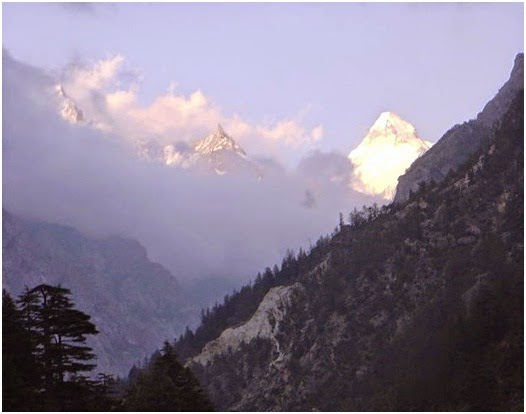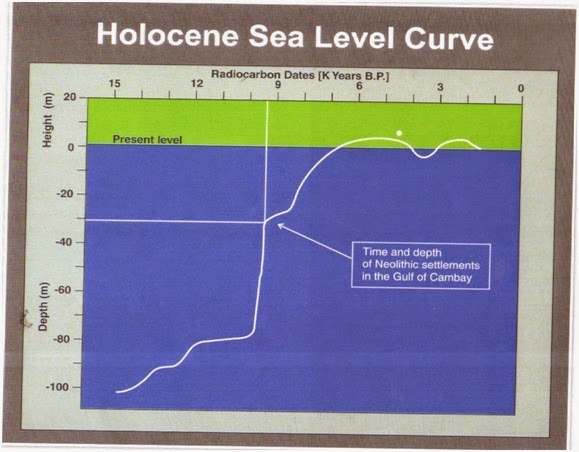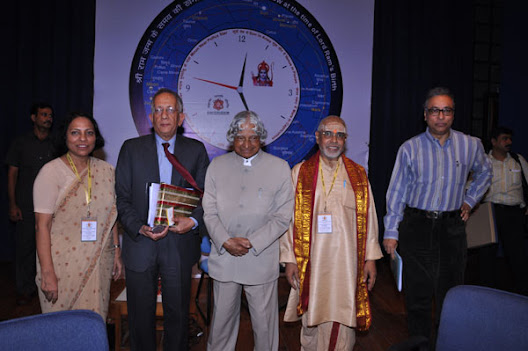Skyviews of
astronomical references in Rigveda & Ramayan have revealed that these
represent the sky observed between 9000 BP and 7000 BP, whereas those of
Mahabharata could be observed around 5000 BP. The archaeological excavations
along the ancient courses of Saraswati and Indus rivers have reconstructed the
history of Harappan Civilization which flourished in Indian Subcontinent
between 6000 BP to 3500 BP. These have revealed that Harappans represented post
Vedic civilization and there was continuity of culture since the Rigvedic era
besides the other evidences.
In addition to all these evidences
which through light on the continuity of culture during the Holocene and since
Rigvedic Era, a very large number of seals found from Harappan sites have
supported the conclusion that Harappan were Vedic people. Various attempts made
earlier to decipher these seals had failed because attempts were being made to
decipher these in isolation without taking into account the contemporary or
previous language and literature. . In fact the seals could have been
deciphered only after reading the Vedic literature and Rigvedic Sanskrit
because a script cannot be independent of language.
Dr. S.R. Rao & Dr. N. Jha appreciated
the point that a script can’t be deciphered by using a non-existent language.
That is why they made most successful attempt at deciphering the Harappan seals
as they read these in the context of Vedic words & Vedic language. Dr.
N.Jha referred to Nighantu, a concise glossary of key vedic words compiled by
sage Yaska, referred to in Shanti parva in epic Mahabharata and
to Nirukta (Shanti Parva.342.73, 93, 89).
After comprehensive analysis of
script on the seals and its consistency with Vedic wsords and expressions, he concluded
that the language of the seals represented the Vedic Sanskrit while the writing
itself is proto-alphabetical, representing an intermediate stage in the
evolution from a primitive consonantal (syllabic) system to the scientific
alphabetical writing, which is the unique achievement of the Indian civilization.
In Indus writing, a
word consists of a string of consonants, whereas vowels were to be supplied
keeping the context in mind. Where ever the word was to begin with vowel, a ‘U’
shaped symbol was provided. In this way Dr. N. Jha very convincingly deciphered
most of the seals. The details of such decipherment given in his books e.g.
‘VEDIC GLOSSARY ON INDUS SEALS’ reflect that Harappans were Vedic people, who
combined the Aryans an well as the Dravidian culture, which has continued in
India till date. Some of the examples are given below:
Swastika figurines:
The swastika on a Harappan
tablet (left), and on pottery of the early historical era (top right: Rupar;
bottom right: Ahichchhatra). (@ASI)
Seals from Harappa
The Swastika symbol is an apt example of link between Vedic &
Harappan cultures. The word swastika stands for svasti-ka i.e. ‘maker of welfare’. Both of the above signs appeared
in Vedic literature and were also used in many Vedic ceremonies. The right
figurine in particular represents sacred panca-svasti mantra found in Yajurveda (25.18-19), where the word
‘Svasti’ appears five times as:
तमीशानं
जगतस्तस्थुषस्पतिं धीयञ्जिन्वमवसे हुमहे वयम्।
पूषा नो यथा
वेदसामसद् वृधे रक्षिता पायुरदब्ध: स्वस्तये।। यजुर्वेद (25.18)
स्वस्ति नs इन्द्रो
वृद्धश्रवा: स्वस्ति न: पूषा विश्ववेदा:।
स्वस्ति
नस्तार्क्ष्यो अरिष्टनेमि: स्वस्ति नो बृहस्पतिर्दधातु।। (25.19)
We invoke him who may bring
us welfare,
May the respected Indra
guard our welfare,
May the omniscient Pushan
guard our welfare,
May the Universal Creator
guard our welfare,
May the Great Protector
bring us welfare.
Similar invocations are found in
Rigveda as well. It is important to take note of the fact that such Swastika
seals were found during excavations from several Harappan sites including
Harappa, Mohenjodero, Lothal and Kalibangan.
The Pranavakshara / OM & Ashvattha sign:
One look at these seals depicting Om combined
with Ashvattha leaves will bring before our minds eye several references
in Vedas. The maker of these seals obviously was a tremendous designer and had
good knowledge of Vedas
Fig.1 Fig.2
(Mohenjodero “seal with motif of a two
headed Unicon & the pipal tree in OM Shape after S.R. Rao)
Such seals have
been found from several Harappan towns. When viewed from different angles,
these convey different Vedic Expressions. In Fig.1 the seal represents the
couplet of Mundakopanishad (2.2.4)
which says that “Om is the bow, the soul is the arrow, and Brahma is the
target. With full concentration, aim at the target and strike, to become one
with Brahma, just as the arrow becomes one with the target”.
It also represents a stanza (shloka)
of Bhagavadgita (15.1). “The Ashvattha tree has its roots above and branches down;
this symbolizes the Vishva Vriksha
with branches below and God above. One who understands this has understood the
Vedas.
In Fig.2 the Sanskrit/
Devnagari ‘Om’ apparent.
Bull seals representing Indra
Fig.1 Fig.2
Seal from Harappa
In Vedic literature God Indra is associated with
the bull as the symbol of strength. (Rigveda.1.7.8 & 1.139.6). In Fig.1 the
script engraved was decephered as Indra by Dr. N.Jha. Such seals have
been excavated from several Harappan towns, perticularly Harappa and
Mohenjodero.
Pashupati seal and Shivlinga
Mohenjodero ‘seal 420’ after ‘S.R.Rao’
It is said that a picture is worth a thousand words. The above two
figurines do not need much explanation. Both represent Lord Shiva, who is
worshipped by Vedic Aryans, by Harappans as well as by modern day Indians in
the same shape and form. These should be adequate enough to establish the
connection between Harappan & Vedic civilization and continuity till date.
The inscriptions on 2nd seal need some explanation. To
decipher the inscriptions one need to understand the Niruktas and Nighantus. The
inscription is deciphered by N Jha as ‘ishaadyattah
maaraah’, which means ‘Evil adversaries controlled by Isha (Pashpati Seal)
Seal with a motif of a man holding or keeping apart
two tigers. This seal reminds us of king Bharata, son of Shkuntala
& Dushyant and ancestors of kauravas & pandavas of
Mahabharata.
There are many more such instances
of Indus seals having inscriptions of Vedic expressions. Thus there is no doubt
that Harappans represented the post Vedic civilization and artifacts as well as
the seals found were similar to the descriptions in Rigveda
Bibiliography:-
Saroj Bala, Kulbhushan Mishra. 2012. Historicity
of Vedic and Ramayan Eras
N.S. Rajaram. 2006. Sarasvati River and the Vedic
Civilization
Michel Danino. 2010. The Lost River (on the trail
of the SARASVATI)
Dr. N. Jha. 1996. VEDIC GLOSSARY ON INDUS SEALS
K. S. Valdiya. 2002. SARASWATI (The River that
Disappeared)
Bhagwan Singh. 1995. THE VEDIC HARAPPANS
S. R. RAO. 1991. DAWN AND DEVOLUTION OF THE INDUS
CIVILIZATION
H. H.
WILSON. 2001. RIGVEDA SAMHITA
श्री राम शर्मा. आचार्य. 2003. ऋग्वेद संहिता
M. N. DUTT. 2008. MAHABHARATA


















